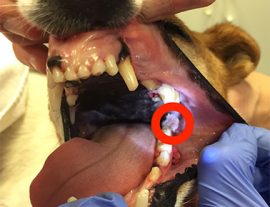Oral papillomas are small benign tumors that can be found growing on the lips, tongue, gums and the inner wall of the mouth of dogs. They often appear as small fleshy pink masses with an irregular surface that resemble that of a cauliflower, and can grow in clusters or as discrete masses.
They are caused by the canine papillomavirus which is spread from direct contact, or sharing food/drink and toys with infected dogs. In young dogs the immature immune system is not developed enough to be able to effectively get rid of the virus before it can cause papillomas to form. However, as their immune system develops, they will be able to get rid of the virus and as a result, these papillomas will usually resolve.
While diagnosis of these masses are often made based on appearance, location and the age of the dog, confirmation requires a section of the mass to be taken as a biopsy for histopathology. This is particularly important in older dogs as they can also resemble other types of tumors that are more malignant, or the papillomas could have come about due to a weakened immune system due to other ongoing diseases, stress or pregnancy.
Oral papillomas tend to be self-resolving and do not need to be removed. Exceptions include if the oral papilloma grow too big or are in numbers that make eating, drinking and swallowing difficult, or if they get infected. In those cases, surgical excision or cryotherapy (freezing) of the papillomas and treatment of the infection with antibiotics may is necessary.
Don’t hesitate to contact the clinic if you have any concerns about growths or changes to the skin of your animal.
By Deborah Chong, Final Year Veterinary Student, University of Sydney


